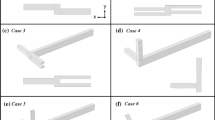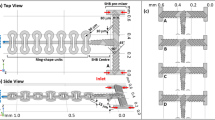Abstract
Effective mixing and a controllable concentration gradient are important in microfluidic applications. From the scaling law, decreasing the mixing length can shorten the mixing time and enhance the mixing quality. The small sizes lead to small Reynolds numbers and a laminar flow in microfluidic devices. Under these conditions, molecular diffusion is the main transport effect during the mixing process. In this paper, we present complete 2D analytical models of convective–diffusive transport in parallel lamination micromixers for a binary system. An arbitrary mixing ratio between solute and solvent is considered. The analytical solution indicates the two important parameters for convective–diffusive transport in microchannels: the Peclet number and the dimensionless mixing length. Furthermore, the model can also be extended to the mixing of multiple streams—a common and effective concept of parallel mixing in microchannels. Using laser machining and adhesive bonding, polymeric micromixers were fabricated and tested to verify the analytical results. The experimental results agree well with the analytical models.












Similar content being viewed by others
References
Nguyen NT, Wereley ST (2003) Fundamentals and applications of microfluidics. Artech House, Boston, Massachusetts
Kamholz AE, Weigl BH, Finlayson BA, Yager P (1999) Quantitative analysis of molecular interaction in a microfluidic channel: the T-sensor. Anal Chem 71:5340–5347
Koch M, Chatelain D, Evans AGR, Brunnschweiler A (1998) Two simple micromixers based on silicon. J Micromech Microeng 8:123–126
Gobby D, Angeli P, Gavriilidis A (2001) Mixing characteristics of T-type microfluidic mixers. J Micromech Microeng 11:126–132
Ehrfeld W, Golbig K, Hessel V, Löwe H, Richter T (1999) Characterization of mixing in micromixers by a test reaction: single mixing units and mixing arrays. Ind Eng Chem Res 38:1075–1082
Erbacher C, Bessoth FG, Busch M, Verpoorte E, Manz A (1999) Towards integrated continuous-flow chemical reactors. Mikrochim Acta 131:19–24
Schwesinger N, Frank T, Wurmus H (1996) A modular microfluid system with an integrated micromixer. J Micromech Microeng 6:99–102
Koch M, Witt H, Evans G, Brunnschweiler A (1999) Improved characterization technique for micromixers. J Micromech Microeng 9:156–158
Handique K, Burns MA (2001) Mathematical modeling of drop mixing in a slit-type microchannel. J Micromech Microeng 11:548–554
Miyake R, Lammerink TSJ, Elwenspoek M, Fluitman JHJ (1993) Micro mixer with fast diffusion. In: Proceedings of the 6th IEEE international workshop on micro electro mechanical systems (MEMS’93), Fort Lauderdale, Florida, February 1993, pp 248–253
He B, Burke BJ, Zhang X, Zhang R, Regnier FE (2001) A picoliter-volume mixer for microfluidic analytical systems. Anal Chem 73:1942–1947
Lin Y, Gerfen GJ, Rousseau DL, Yeh SR (2003) Ultrafast microfluidic mixer and freeze-quenching device. Anal Chem 75:5381–5386
Liu RH, Stremler MA, Sharp KV, Olsen MG, Santiago JG, Adrian RJ, Aref H, Beebe DJ (2000) Passive mixing in a three-dimensional serpentine microchannel. J Microelectromech Syst 9:190–197
Stroock AD, Dertinger SK, Ajdari A, Mezic I, Stone HA, Whitesides GM (2002) Chaotic mixer for microchannels. Science 295:647–650
Wang H, Iovenitti P, Harvey E, Masood S (2003) Numerical investigation of mixing in microchannels with patterned grooves. J Micromech Microeng 13:801–808
Bertsch A, Heimgartner S, Cousseau P, Renaud P (2001) Static micromixers based on large-scale industrial mixer geometry. Lab Chip 1:56–60
Park SJ, Kim JK, Park J, Chung S, Chung C, Chang JK (2004) Rapid three-dimensional passive rotation micromixer using the breakup process. J Micromech Microeng 14:6–14
Evans J, Liepmann D, Pisano AP (1997) Planar laminar mixer. In: Proceeding of the 10th IEEE international workshop on micro electro mechanical systems (MEMS’97), Nagoya, Japan, January 1997, pp 96–101
Liu H, Lenigk R, Druyor-Sanchez RL, Yang J, Grodzinski P (2003) Hybridization enhancement using cavitation microstreaming. Anal Chem 75:1911–1917
Yang Z, Goto H, Matsumoto M, Maeda R (2001) Ultrasonic micromixer for microfluidic systems. Sensor Actuat A–Phys 93:266–272
Oddy MH, Santiago JG, Mikkelsen JC (2001) Electrokinetic instability micromixing. Anal Chem 73:5822–5832
Bao HH, Zhong J, Yi M (2001) A minute magneto hydro dynamic (MHD) mixer. Sensor Actuat B–Chem 79:207–215
Lu LH, Ryu K, Liu C (2002) A magnetic microstirrer and array for microfluidic mixing. J Microelectromech Syst 11:462–469
Tsai JH, Lin L (2002) Active microfluidic mixer and gas bubble filter driven by thermal bubble micropump. Sensor Actuat A–Phys 97–98:665–671
Ismagilov RF, Stroock AD, Kenis PJA, Whitesides G, Stone HA (2000) Experimental and theoretical scaling laws for transverse diffusive broadening in two-phase laminar flows in microchannels. Appl Phys Lett 76:2376–2378
Kamholz AE, Yager P (2002) Molecular diffusive scaling laws in pressure-driven microfluidic channels: deviation from one-dimensional Einstein approximations. Sensor Actuat B–Chem 82:117–121
Brenner H, Edwards DA (1993) Macrotransport processes. Butterworth-Heinemann, Boston, Massachusetts
Berad DA (2001) Taylor dispersion of a solute in a microfluidic channel. J Appl Phys 89:4467–4469
Dorfman KD, Brenner H (2001) Comment on “Taylor dispersion of a solute in a microfluidic channel.” J Appl Phys 90:6553–6554
Beard DA (2001) Response to “Comment on “Taylor dispersion of a solute in a microfluidic channel” [J Appl Phys 90:6553]”. J Appl Phys 90:6555–6556
Holden MA, Kumar S, Castellana E, Beskok A, Cremer PS (2003) Generating fixed concentration arrays in a microfluidic device. Sensor Actuat B–Chem 92:199–207
Cussler EL (1984) Diffusion: mass transfer in fluid systems. Cambridge University Press, New York
Wu ZG, Nguyen NT, Huang XY (2004) Nonlinear diffusive mixing in microchannels: theory and experiments. J Micromech Microeng 14:604–611
Galambos P, Forster F (1998) An optical micro-fluidic viscometer. In: Proceedings of the ASME international mechanical engineering congress and exposition, Anaheim, California, November 1988, pp 187–191
Stiles PJ, Fletcher DF (2004) Hydrodynamic control of the interface between two liquids flowing through a horizontal or vertical microchannel. Lab Chip 4:121–124
Gaskell DR (1995) Introduction to thermodynamics of materials, 3rd edn. Taylor and Francis, London
Bassi FA, Arcovito G, D’Abramo G (1977) An improved optical method of obtaining the mutual diffusion coefficient from the refractive index gradient profile. J Phys E Sci Instrum 10:249–253
Timmermans J (1960) The physio-chemical constants of binary systems in concentrated solution. Interscience, New York
Einstein A (1956) Investigation on the theory of the Brownian movement. Dover, New York
Acknowledgements
This work was supported by the academic research fund of the Ministry of Education Singapore, contract number RG11/02. The first author wishes to gratefully acknowledge the PhD scholarship from Nanyang Technological University.
Author information
Authors and Affiliations
Corresponding author
Rights and permissions
About this article
Cite this article
Wu, Z., Nguyen, NT. Convective–diffusive transport in parallel lamination micromixers. Microfluid Nanofluid 1, 208–217 (2005). https://doi.org/10.1007/s10404-004-0011-x
Received:
Accepted:
Published:
Issue Date:
DOI: https://doi.org/10.1007/s10404-004-0011-x




